ECU Citroen C4 PICASSO 2016 2.G Owner's Manual
[x] Cancel search | Manufacturer: CITROEN, Model Year: 2016, Model line: C4 PICASSO, Model: Citroen C4 PICASSO 2016 2.GPages: 527, PDF Size: 13.72 MB
Page 32 of 527
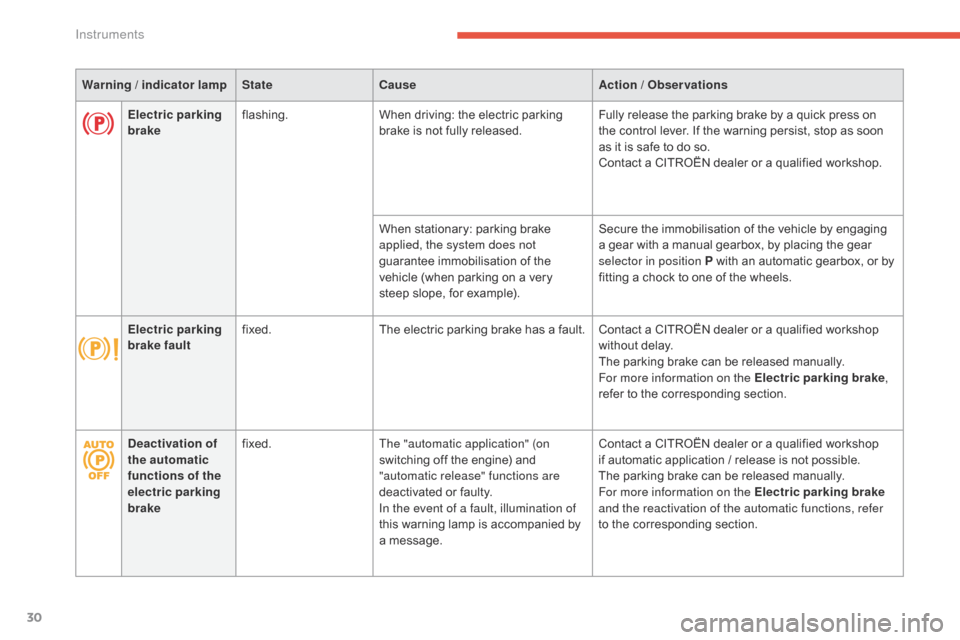
30
C4-Picasso-II_en_Chap01_instruments-bord_ed01-2016
Warning / indicator lampStateCause Action / Observations
Deactivation of
the automatic
functions of the
electric parking
brake fixed.
The "automatic application" (on
switching
off the engine) and
"
automatic release" functions are
deactivated
or faulty.
In the event of a fault, illumination of
this
warning lamp is accompanied by
a
message.Contact
a CITROËN dealer or a qualified workshop
if
automatic application / release is not possible.
The
parking brake can be released manually.
For more information on the Electric parking brake
and the reactivation of the automatic functions, refer
to
the corresponding section.
Electric parking
brake
flashing.
When
driving: the electric parking
b
rake is not fully released.Fully
release the parking brake by a quick press on
t
he control lever. If the warning persist, stop as soon
a
s it is safe to do so.
Contact
a CITROËN dealer or a qualified workshop.
When
stationary: parking brake
a
pplied, the system does not
guarantee
immobilisation of the
v
ehicle (when parking on a very
s
teep slope, for example).Secure
the immobilisation of the vehicle by engaging
a
gear with a manual gearbox, by placing the gear
s
elector in position P with an automatic gearbox, or by
f
itting a chock to one of the wheels.
Electric parking
brake fault fixed.
The
electric parking brake has a fault. Contact a CITROËN dealer or a qualified workshop
w
ithout delay.
The
parking brake can be released manually.
For more information on the Electric parking brake ,
refer
to the corresponding section.
Instruments
Page 62 of 527
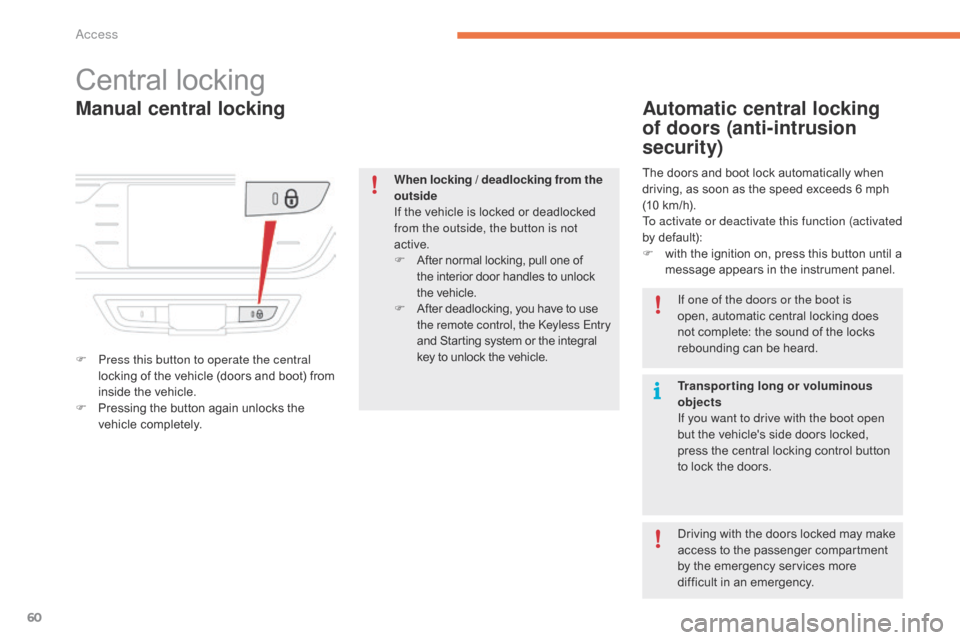
60
C4-Picasso-II_en_Chap02_ouvertures_ed01-2016
Manual central locking
Central locking
F Press this button to operate the central locking of the vehicle (doors and boot) from
i
nside the vehicle.
F
P
ressing the button again unlocks the
v
ehicle
c
ompletely.
Automatic central locking
of doors (anti-intrusion
security)
The doors and boot lock automatically when driving, as soon as the speed exceeds 6 mph
(
10 km/h).
To activate or deactivate this function (activated
by
default):
F
w
ith the ignition on, press this button until a
m
essage appears in the instrument panel.
When locking / deadlocking from the
outside
If
the
vehicle
is
locked
or
deadlocked
f
rom the outside, the button is not
active.
F
A
fter
normal
locking,
pull
one
of
t
he
interior
door
handles
to
unlock
t
he vehicle.
F
A
fter
deadlocking,
you
have
to
use
t
he remote control, the Keyless Entry
and
Starting
system
or
the
integral
k
ey
to
unlock
the
vehicle. If one of the doors or the boot is
open,
automatic central locking does
n
ot complete: the sound of the locks
r
ebounding can be heard.
Transporting long or voluminous
objects
If you want to drive with the boot open
but
the vehicle's side doors locked,
p
ress the central locking control button
t
o lock the doors.
Driving
with the doors locked may make
a
ccess to the passenger compartment
b
y the emergency services more
d
ifficult in an emergency.
Access
Page 109 of 527
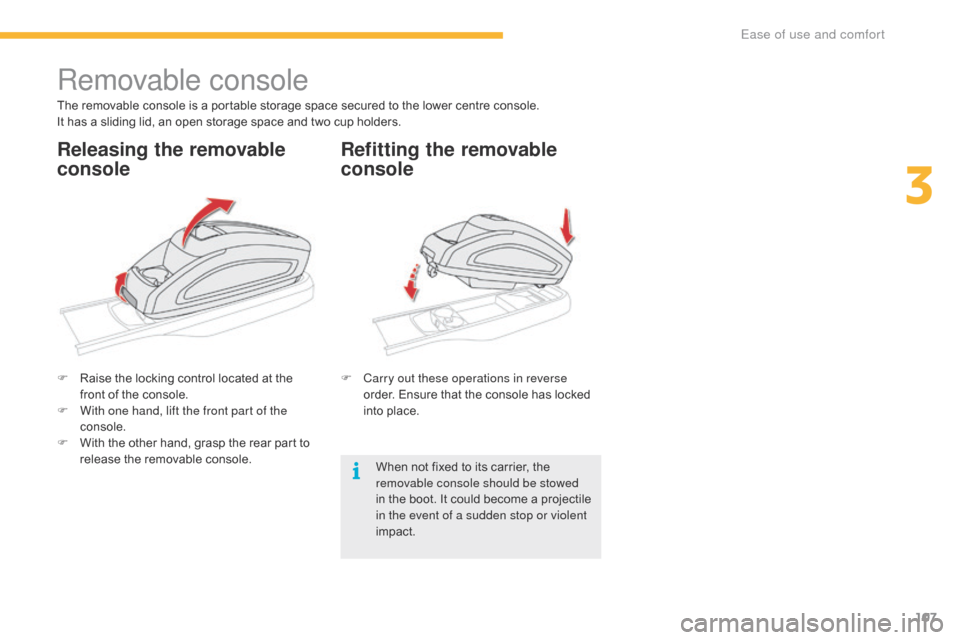
107
C4-Picasso-II_en_Chap03_ergonomie-confort_ed01-2016
Removable console
The removable console is a portable storage space secured to the lower centre console.
I t has a sliding lid, an open storage space and two cup holders.
F
R
aise the locking control located at the
f
ront of the console.
F
W
ith one hand, lift the front part of the
console.
F
W
ith the other hand, grasp the rear part to
r
elease the removable console.F
C
arry out these operations in reverse
order.
Ensure that the console has locked
i
nto place.
When
not fixed to its carrier, the
r
emovable console should be stowed
in
the boot. It could become a projectile
i
n the event of a sudden stop or violent
impact.
Releasing the removable
console Refitting the removable
console
3
Ease of use and comfort
Page 112 of 527
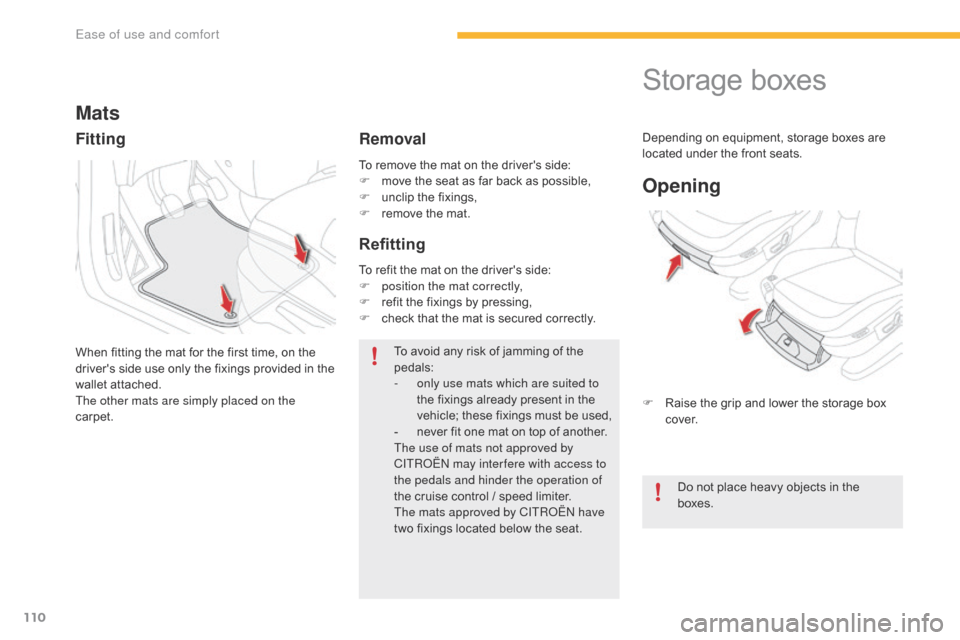
110
C4-Picasso-II_en_Chap03_ergonomie-confort_ed01-2016
To remove the mat on the driver's side:
F m ove the seat as far back as possible,
F
u
nclip the fixings,
F
r
emove the mat.
Mats
When fitting the mat for the first time, on the driver's side use only the fixings provided in the
w
allet attached.
The other mats are simply placed on the
carpet. To
avoid any risk of jamming of the ped
als:
-
o
nly use mats which are suited to
the
fixings already present in the
v
ehicle; these fixings must be used,
-
n
ever fit one mat on top of another.
The use of mats not approved by
CITROËN may inter fere with access to
the pedals and hinder the operation of
the
cruise control / speed limiter.
The mats approved by CITROËN have
two
fixings located below the seat.
To
refit the mat on the driver's side:
F
p
osition the mat correctly,
F
r
efit the fixings by pressing,
F
c
heck that the mat is secured correctly.
Fitting
Removal
Refitting
Storage boxes
F Raise the grip and lower the storage box c
ove r.
Opening
Do not place heavy objects in the boxes.
Depending
on equipment, storage boxes are
l
ocated under the front seats.
Ease of use and comfort
Page 118 of 527
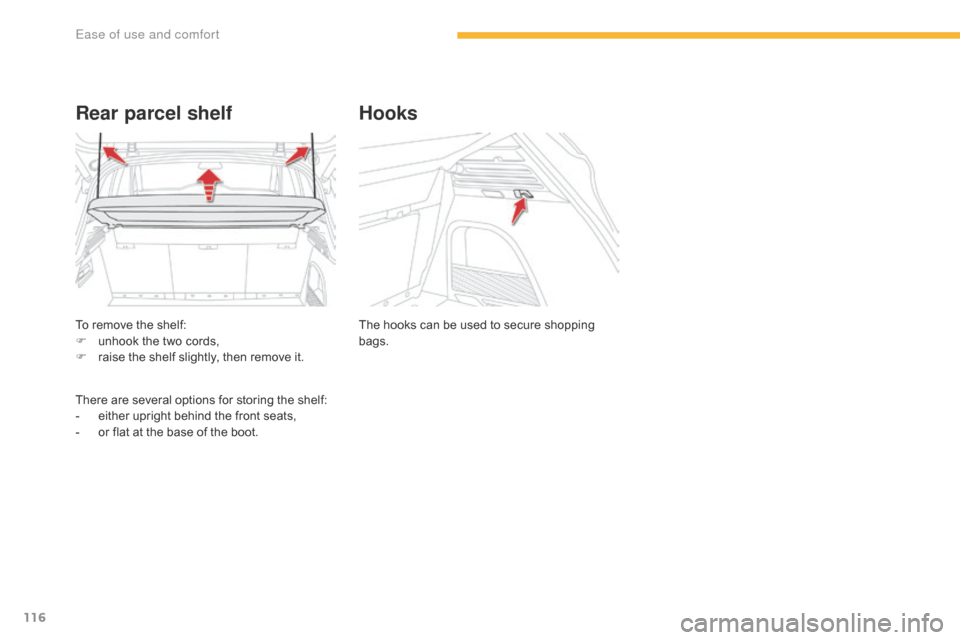
116
C4-Picasso-II_en_Chap03_ergonomie-confort_ed01-2016
To remove the shelf:
F u nhook the two cords,
F
r
aise the shelf slightly, then remove it.
Rear parcel shelf
There are several options for storing the shelf:
- e ither upright behind the front seats,
-
o
r flat at the base of the boot.The
hooks can be used to secure shopping
b
ags.
Hooks
Ease of use and comfort
Page 133 of 527
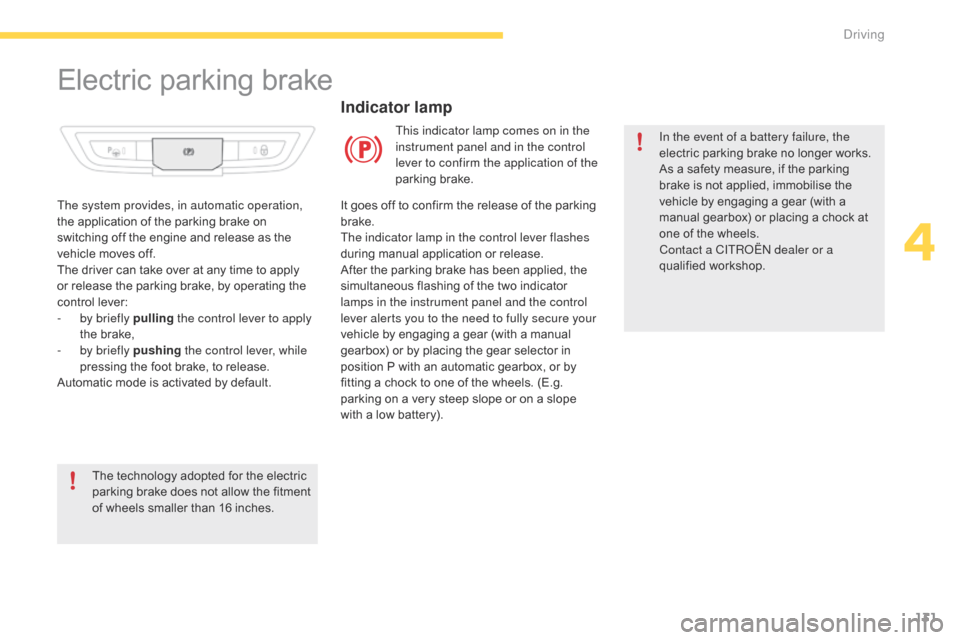
131
C4-Picasso-II_en_Chap04_conduite_ed01-2016
Electric parking brake
In the event of a battery failure, the
electric parking brake no longer works.
As
a safety measure, if the parking
b
rake is not applied, immobilise the
v
ehicle by engaging a gear (with a
m
anual gearbox) or placing a chock at
o
ne of the wheels.
Contact a CITROËN dealer or a
qualified
w
orkshop.
Indicator lamp
This indicator lamp comes on in the
instrument panel and in the control
lever to confirm the application of the
parking
b
rake.
The system provides, in automatic operation,
the
application
of
the
parking
brake
on
s
witching
off
the
engine
and
release
as
the
v
ehicle
moves
off.
The
driver
can
take
over
at
any
time
to
apply
o
r
release
the
parking
brake,
by
operating
the
c
ontrol
lever:
-
b
y briefly pulling the control lever to apply
the
brake,
-
b
y briefly pushing the control lever, while
pressing
the
foot
brake,
to
release.
Automatic
mode
is
activated
by
default.
The
technology
adopted
for
the
electric
p
arking
brake
does
not
allow
the
fitment
o
f
wheels
smaller
than
16
inches. It
goes
off
to confirm the release of the parking
b
rake.
The indicator lamp in the control lever flashes
during
manual application or release.
After
the
parking brake has been applied, the
s
imultaneous flashing of the two indicator
l
amps in the instrument panel and the control
lever alerts you to the need to fully secure your
vehicle
by
engaging a gear (with a manual
g
earbox)
or by placing the gear selector in
p
osition
P
with an automatic gearbox, or by
f
itting
a
chock to one of the wheels. (E.g.
p
arking
on a very steep slope or on a slope
w
ith
a
low
battery).
4
Driving
Page 139 of 527

137
C4-Picasso-II_en_Chap04_conduite_ed01-2016
SituationsConsequences
Display of the message "Parking brake fault " and these
warning
lam
ps: The
parking brake is faulty, the manual and automatic functions may not operate.
When stationary ,
to immobilise your vehicle:
-
P
ull and hold the control lever for about 7 to 15 seconds, until the warning lamp
c
omes on in the instrument panel.
If
this procedure does not work, you should make your vehicle safe:
-
P
ark on a level sur face.
-
E
ngage a gear with a manual gearbox, or place the gear selector at position P
with
an automatic gearbox.
-
I
f possible, fit a wheel chock.
Call
on a CITROËN dealer or a qualified workshop.
Display
of the message "Parking brake fault " and these
warning
lam
ps: -
T
he parking brake does not have its full per formance to securely hold the vehicle
i
n all situations.
You
should make your vehicle safe:
-
P
ark on a level sur face.
-
E
ngage a gear with a manual gearbox, or place the gear selector at position P
with
an automatic gearbox.
-
I
f possible, fit a wheel chock.
Call
on a CITROËN dealer or a qualified workshop.
The
flashing of the P warning lamps on starting the vehicle indicates that the parking
b
rake is not correctly applied.
As
soon as possible, stop the vehicle and try to completely release the parking brake,
u
sing the control lever, with your foot on the brake pedal.
Display
of the message "Battery fault "
and this warning lamp:-
T
he state of charge of the battery is very low and requires immobilisation of the
v
ehicle in a safe place: engage a gear with a manual gearbox or fit a chock to
o
ne of the wheels.
-
O
nce the battery is completely discharged, the controls do not operate: to
r
elease the parking brake, call on a CITROËN dealer or a qualified workshop.
4
Driving
Page 158 of 527
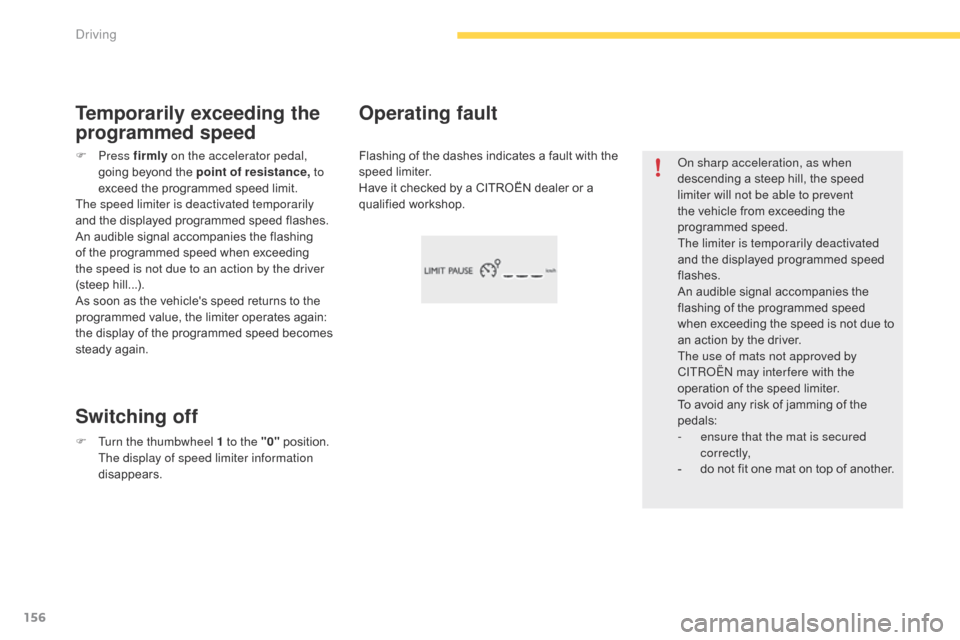
156
C4-Picasso-II_en_Chap04_conduite_ed01-2016
On sharp acceleration, as when
descending a steep hill, the speed
l
imiter will not be able to prevent
the
vehicle from exceeding the
pro
grammed
s
peed.
The limiter is temporarily deactivated
and
the displayed programmed speed
f
lashes.
An
audible signal accompanies the
f
lashing of the programmed speed
w
hen exceeding the speed is not due to
a
n action by the driver.
The use of mats not approved by
CITROËN may inter fere with the
operation
of the speed limiter.
To
avoid any risk of jamming of the
ped
als:
-
e
nsure that the mat is secured
c o r r e c t l y,
-
d
o not fit one mat on top of another.
Flashing
of
the
dashes
indicates
a
fault
with
the
sp
eed l
imiter.
Have
it
checked
by
a
CITROËN
dealer
or
a
q
ualified
w
orkshop.
Operating fault
F Press f irmly on the accelerator pedal,
going beyond the point of resistance, to
exceed
the programmed speed limit.
The speed limiter is deactivated temporarily
and
the displayed programmed speed flashes.
An
audible signal accompanies the flashing
o
f the programmed speed when exceeding
t
he speed is not due to an action by the driver
(steep
h
ill...).
As
soon as the vehicle's speed returns to the
p
rogrammed value, the limiter operates again:
t
he display of the programmed speed becomes
s
teady again.
Switching off Temporarily exceeding the
programmed speed
F Turn the thumbwheel 1 to the "0" p osition. T
he display of speed limiter information
disappears.
Driving
Page 161 of 527
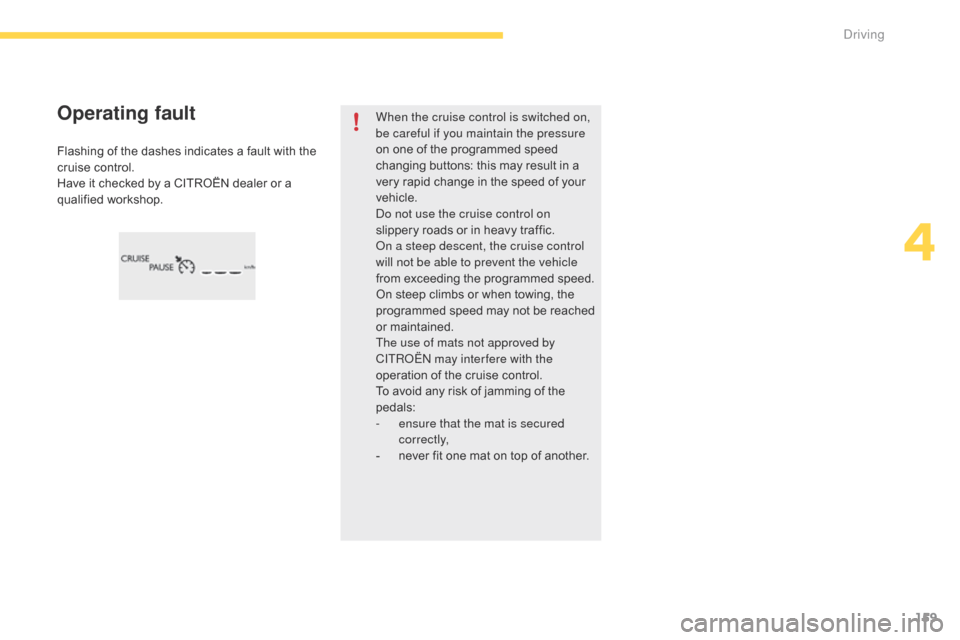
159
C4-Picasso-II_en_Chap04_conduite_ed01-2016
Flashing of the dashes indicates a fault with the cruise control.
Have
it checked by a CITROËN dealer or a
q
ualified
w
orkshop.
Operating faultWhen the cruise control is switched on,
be careful if you maintain the pressure
on one of the programmed speed
c
hanging buttons: this may result in a
v
ery rapid change in the speed of your
v
ehicle.
Do not use the cruise control on
slippery
roads or in heavy traffic.
On a steep descent, the cruise control
will not be able to prevent the vehicle
from
exceeding the programmed speed.
On
steep climbs or when towing, the
p
rogrammed speed may not be reached
o
r maintained.
The use of mats not approved by
CITROËN may inter fere with the
operation
of the cruise control.
To
avoid any risk of jamming of the
ped
als:
-
e
nsure that the mat is secured
c o r r e c t l y,
-
n
ever fit one mat on top of another.
4
Driving
Page 168 of 527
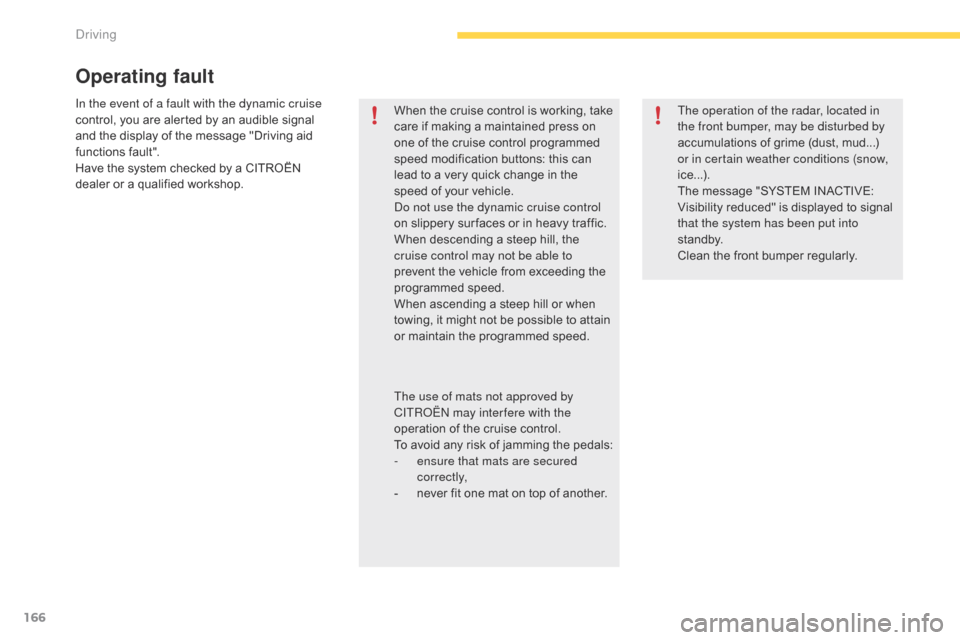
166
C4-Picasso-II_en_Chap04_conduite_ed01-2016
In the event of a fault with the dynamic cruise
control, you are alerted by an audible signal
a
nd the display of the message "Driving aid
f
unctions
f
ault".
Have
the system checked by a CITROËN
d
ealer or a qualified workshop. When
the cruise control is working, take
c
are if making a maintained press on
o
ne of the cruise control programmed
s
peed modification buttons: this can
l
ead to a very quick change in the
s
peed of your vehicle.
Do not use the dynamic cruise control
on
slippery sur faces or in heavy traffic.
When
descending a steep hill, the
c
ruise control may not be able to
prevent
the vehicle from exceeding the
pro
grammed
s
peed.
When
ascending a steep hill or when
t
owing, it might not be possible to attain
o
r maintain the programmed speed.
Operating fault
The operation of the radar, located in
the front bumper, may be disturbed by
accumulations of grime (dust, mud...)
o
r in certain weather conditions (snow,
ice...).
The
message "SYSTEM INACTIVE:
V
isibility reduced" is displayed to signal
t
hat the system has been put into
st a n dby.
Clean
the front bumper regularly.
The use of mats not approved by
CITROËN may inter fere with the
operation
of
the
cruise
control.
To
avoid
any
risk
of
jamming
the
pedals:
-
e
nsure that mats are secured
c o r r e c t l y,
-
n
ever
fit
one
mat
on
top
of
another.
Driving